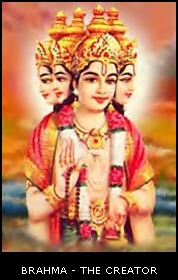Lord Brahma
Lord Brahma symbolizes the aspect of the
 Supreme Reality that brings forth the creation.
For this very reason, Hindus call Lord Brahma the
Creator of the universe. He is the first member of
the Hindu Trinity that also includes Lord Vishnu
and Lord Shiva. His divine consort is Saraswati,
the Goddess of learning and knowledge. Goddess
Saraswati provides Lord Brahma with knowledge that
is necessary for the process of creation.
Supreme Reality that brings forth the creation.
For this very reason, Hindus call Lord Brahma the
Creator of the universe. He is the first member of
the Hindu Trinity that also includes Lord Vishnu
and Lord Shiva. His divine consort is Saraswati,
the Goddess of learning and knowledge. Goddess
Saraswati provides Lord Brahma with knowledge that
is necessary for the process of creation.
Brahma is usually conceived of by Hindus as a
bearded, four-faced, four-armed deity. In popular
images, He carries a rosary in the upper right
hand, a book in the upper left hand, a kamandalu
(water pot) in the lower left hand, and bestows
grace with His lower right hand. The four faces
represent the sacred knowledge of the four Vedas
(Rig, Yajur, Sama, and Atharva), and this is the
most prominent feature of any image of Brahma. The
four faces, therefore, symbolize that Brahma is
the source of all knowledge necessary for the
creation of the universe. The four arms represent
the four directions and thus represent the
omnipresence and omnipotence of Lord Brahma.
The four hands represent the four aspects of
human personality: mind (back right hand),
intellect (back left hand), ego (front right
hand), and the empirical self or conditioned
consciousness (front left hand). The rosary
symbolizes the time cycle through which the world
moves from creation to sustenance, from sustenance
to dissolution, and from dissolution to new
creation. The rosary also symbolizes the materials
used in the process of creation. Its position in
the back right hand suggests the intelligent use
of these materials in the process of creation.
A book in the back hand (symbolizing the
intellect) illustrates that right knowledge is
important for any kind of creative work. A water
pot (kamandalu) in the front left hand symbolizes
the cosmic energy by which Brahma brings the
universe into existence. The hand symbolizing ego
(the front right hand) is shown in the pose of
bestowing grace. This conveys the idea that the
Lord bestows grace and protects all sincere
devotees.
The color gold symbolizes activity and thus the
golden face of Brahma indicates that the Lord is
active when involved in the process of creation.
The white beard denotes wisdom and the long beard
conveys the idea that creation is an eternal
process. The crown on the head of the Lord implies
that the Lord has supreme power and authority over
the process of creation.
The lotus symbolizes the Supreme Reality, the
essence of all things and beings in the universe.
Brahma sitting or standing on a lotus indicates
that He represents the creative power of the
Supreme Reality. The color white symbolizes
purity. Thus Brahma wearing clothes that are
off-white, represents the dual nature of creation,
that is purity and impurity, happiness and
unhappiness, vice and virtue, knowledge and
ignorance, and so on.
In Hindu mythology, a swan is said to possess a
unique discriminating faculty, which enables it to
distinguish pure milk from a mixture of milk and
water. The swan is therefore used to symbolize the
power of discrimination. Brahma uses the swan as a
vehicle. This is intended to convey the idea that
although creation is pluralistic in nature, there
is only one Supreme Reality that the entire
universe emanates from. This knowledge can be
acquired by an individual by training his mind and
Intellect to acquire the power of right
discrimination.
As creation is the work of the mind and the
intellect, Lord Brahma symbolizes the Universal
Mind. From the standpoint of an individual, Brahma
symbolizes one's own mind and intellect. Since an
individual is naturally gifted with the mind and
intellect, he or she may be said to have already
realized Brahma. For this reason the worship of
Brahma is not very popular among all Hindus. He
is, however, worshipped by seekers of knowledge,
such as students, teachers, scholars and
scientists.
- Bansi Pandit
| 